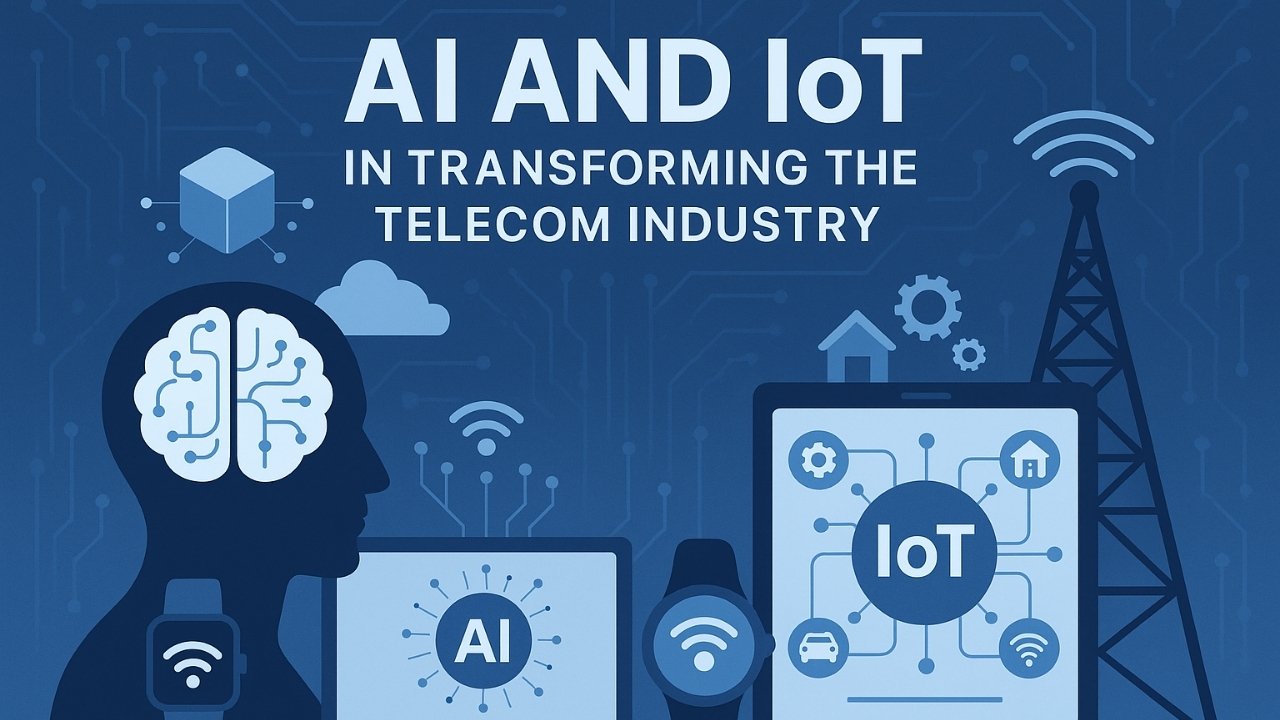The telecom sector has evolved far beyond voice and text-based services. Today, it supports a wide range of digital communication technologies that serve over 5 billion mobile users globally. The rapid surge in data consumption, increased device connectivity, and the emergence of 5G have created both new opportunities and operational complexities. This digital transformation is being effectively managed with the integration of Artificial Intelligence (AI) and the Internet of Things (IoT).
As per GSMA data, mobile data traffic exceeded 100 exabytes per month globally in 2024 and is projected to triple by 2028. Managing such exponential data growth using traditional telecom infrastructure is no longer feasible. AI and IoT are emerging as transformative technologies that help optimize networks, enhance service delivery, and reduce operating costs while enabling real-time customer service and predictive operations.
Moreover, telecom operators are shifting their role from just service providers to technology solution enablers. With AI analyzing data patterns and IoT providing continuous input from connected devices, telecom firms are uniquely positioned to support applications like smart cities, remote diagnostics, intelligent billing, and advanced cybersecurity.
Enhancing Network Operations with Artificial Intelligence

One of the most impactful applications of AI in telecom is in automating network management. AI algorithms help analyze network traffic in real time, allowing operators to dynamically adjust bandwidth, detect faults, and reroute data to avoid congestion. This significantly improves the Quality of Service (QoS), especially in urban areas with high user density.
AI also plays a crucial role in predictive maintenance, where it identifies potential points of failure based on historical performance and sensor data. This proactive approach reduces downtime and ensures uninterrupted connectivity, which is especially critical for enterprise clients and essential services.
In customer support, AI-driven virtual agents now manage a large portion of first-level queries. These chatbots, powered by Natural Language Processing (NLP), understand regional languages and slang, leading to faster response times and reduced human workload. AI also contributes to personalized offerings by analyzing customer behavior and suggesting tailored data plans or value-added services.
| Area of Implementation | AI Functionality | Business Value Delivered |
|---|---|---|
| Network Optimization | Traffic prediction, anomaly detection | Lower latency, higher uptime |
| Customer Support | Virtual agents, NLP-based interactions | Enhanced customer satisfaction |
| Fraud Detection | Behavioral pattern analytics | Reduced financial and reputational risk |
| Service Personalization | User profiling, predictive offers | Improved user retention and ARPU growth |
Additionally, AI facilitates fraud detection by identifying anomalies in call patterns or billing systems. Telecom companies deal with billions of transactions daily, and manual fraud checks are inefficient. AI automates the detection of irregularities, SIM cloning, and unusual usage patterns, safeguarding revenue and customer trust.
Empowering Connectivity Through IoT Integration
IoT is central to telecom expansion as it enables billions of connected devices—from home appliances and wearables to industrial machines and utility systems to communicate via telecom networks. These devices generate constant data streams, which telecom firms manage using dedicated IoT platforms and custom connectivity protocols like NB-IoT and LTE-M.
Telecom operators also use IoT internally to monitor network towers, fiber cables, and energy consumption at remote sites. Sensors on these assets send real-time updates on temperature, signal strength, and power supply, which help in rapid issue resolution. This enables energy-efficient operations and better infrastructure planning.
IoT also supports telecom services diversification. For example, telecom companies are increasingly offering smart home products bundled with data plans. These include IoT-enabled routers, security cameras, and smart assistants—all monitored and serviced through telecom apps.
Use Cases of IoT in the Telecom Ecosystem
| Use Case | Device/Technology Involved | Outcome and Benefits |
|---|---|---|
| Infrastructure Monitoring | Tower sensors, smart meters | Reduced downtime and proactive servicing |
| Smart Home Integration | IoT routers, surveillance systems | Additional revenue streams, user convenience |
| Asset Tracking | GPS-enabled SIM devices | Efficient logistics and inventory management |
| Smart City Support | Urban IoT networks, traffic sensors | Improved public services via reliable data |
With IoT enabling telecoms to manage both internal systems and customer-facing solutions, their role in digital transformation becomes more essential. Furthermore, the transition to 5G is enhancing the IoT potential with its low-latency, high-bandwidth capabilities, allowing more devices to connect simultaneously with near-instantaneous communication.
Combined Impact: Where AI Meets IoT in Telecom
The true potential of digital transformation in telecom lies in the integration of AI and IoT, often termed AIoT. Together, these technologies enable smart decision-making in real-time, automate network configurations, and improve data utilization.
For example, AI can analyze data from thousands of IoT devices spread across a smart city to optimize energy usage, traffic flow, or emergency responses. In telecom infrastructure, this integration helps build self-optimizing networks (SONs), where AI learns from IoT data to continuously improve signal distribution, load balancing, and fault detection without human input.
Another critical domain is cybersecurity. With millions of connected devices, the attack surface for telecoms is vast. AIoT frameworks analyze device behavior to flag abnormalities, detect potential breaches, and initiate automated responses before any damage occurs.
Examples of AIoT in Real-World Telecom Deployments
- AI-based monitoring of IoT-connected base stations to optimize energy and uptime
- Predictive analytics using IoT sensor data to allocate bandwidth during peak hours
- AI-managed IoT endpoints in homes for automated troubleshooting of broadband issues
In customer-facing applications, AIoT powers smart billing, where real-time IoT usage data is analyzed to generate event-based invoices, eliminating billing errors and improving transparency.
Addressing Implementation Challenges and Operational Risks
Despite its potential, AI and IoT deployment in telecom is not without barriers. Infrastructure upgrades, talent shortages, and compliance issues are key concerns that slow down mass adoption.
Financial investment is a primary hurdle. Establishing edge computing networks, AI-powered analytics engines, and secure IoT frameworks requires significant capital, especially for mid-size operators. Additionally, managing legacy systems while implementing new technology creates compatibility issues.
There are also regulatory and data privacy concerns. Telecoms operate in highly regulated environments and must comply with local and global frameworks like GDPR, CCPA, and India’s Digital Personal Data Protection Act. Ensuring AI decision-making is transparent and IoT data is securely handled is crucial to maintaining trust.
Top Operational Barriers in AI-IoT Integration for Telecom
- Upfront capital expenditure for infrastructure modernization
- Technical challenges in legacy system integration
- Data security threats due to increased IoT surface area
- Shortage of skilled professionals in AI/ML and IoT domains
Tackling these challenges requires phased adoption, cross-functional collaboration, and partnerships with cloud, cybersecurity, and analytics service providers. Open-source tools and standardized APIs are also helping bridge the interoperability gap between devices and platforms.
What the Future Holds for AI and IoT in Telecom
The future of telecom will be defined by intelligent, responsive, and adaptive networks, driven by AI and enabled by IoT. With 5G rollout expanding and 6G research already underway, telecom networks will support hyper-connectivity, low-latency use cases like autonomous vehicles, remote surgery, and industrial automation.
Telecom companies will evolve into digital service providers offering AI-enabled platforms to businesses, governments, and end users. From contextual voice assistants to AIoT-powered smart cities, the scope of innovation is vast.
In conclusion, the fusion of AI and IoT in telecom is not just an operational upgrade but a paradigm shift in how services are delivered, managed, and monetized. As these technologies mature, the telecom industry will not only support global digital transformation but also lead it.

Harshit Chahal is a policy writer who focuses on rural development, state-specific welfare schemes, and agriculture-linked benefits. Coming from a small-town background, he brings grounded insights into how government initiatives impact real lives. Harshit is committed to making public policy content accessible for rural and semi-urban readers across India.